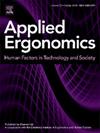Biomechanical analysis on neurotypical and autism spectrum disorder people during human-cobot interaction
IF 3.4
2区 工程技术
Q2 ENGINEERING, INDUSTRIAL
引用次数: 0
Abstract
Biomechanical analysis is essential for assessing subjects interacting with robotic setups and platforms. However, in industrial scenarios, workers’ biomechanics are assessed mainly through questionnaires and scales which provide limited objectivity. Very few studies analyzed the biomechanics of workers in multiple sessions, and no study assessed diverse populations of workers. Therefore, we collected tracking data from 14 neurotypical and 7 participants with autism spectrum disorder (ASD) performing assembly tasks in a lab-based industrial collaborative workcell. Human tracking data were acquired by an Azure Kinect and elaborated with a biomechanical model that allowed to compute human kinematics and dynamics. The biomechanics of neurotypical and ASD operators were compared across two working sessions. Both neurotypical and people characterized by ASD decreased torque and power in the second session with respect to the first one, indicating adaptation to the working activity. Interestingly, ASD people expended more energy than neurotypical, suggesting a higher risk of fatigue. Overall, ASD people performed similarly to neurotypical people from a biomechanical point of view. In this study, we showed a protocol for multisession biomechanical monitoring of workers during industrial human-robot collaboration tasks that can be employed in real scenarios and with ASD workers. This approach can be useful in human-robot collaboration to design minimum-fatigue collaborative tasks, support physical health, and improve ergonomics for workers.
神经典型和自闭症谱系障碍人群人机交互过程中的生物力学分析
生物力学分析对于评估受试者与机器人装置和平台的互动至关重要。然而,在工业场景中,工人的生物力学主要通过问卷和量表进行评估,这提供了有限的客观性。很少有研究分析工人在多个会议中的生物力学,也没有研究评估不同人群的工人。因此,我们收集了14名神经正常和7名自闭症谱系障碍(ASD)参与者在实验室工业协作工作单元中执行组装任务的跟踪数据。人体跟踪数据由Azure Kinect获取,并使用允许计算人体运动学和动力学的生物力学模型进行详细阐述。在两个工作期间比较了神经正常和ASD操作员的生物力学。与第一次相比,在第二次会议中,神经正常型和ASD特征的人的扭矩和功率都有所下降,表明对工作活动的适应。有趣的是,自闭症患者比正常人消耗更多的能量,这表明他们疲劳的风险更高。总的来说,从生物力学的角度来看,ASD患者的表现与神经正常的人相似。在这项研究中,我们展示了一种在工业人机协作任务中对工人进行多会话生物力学监测的协议,该协议可用于真实场景和ASD工人。该方法可用于人机协作,以设计最小疲劳的协作任务,支持身体健康,并改善工人的人体工程学。
本文章由计算机程序翻译,如有差异,请以英文原文为准。
求助全文
约1分钟内获得全文
求助全文
来源期刊

Applied Ergonomics
工程技术-工程:工业
CiteScore
7.50
自引率
9.40%
发文量
248
审稿时长
53 days
期刊介绍:
Applied Ergonomics is aimed at ergonomists and all those interested in applying ergonomics/human factors in the design, planning and management of technical and social systems at work or leisure. Readership is truly international with subscribers in over 50 countries. Professionals for whom Applied Ergonomics is of interest include: ergonomists, designers, industrial engineers, health and safety specialists, systems engineers, design engineers, organizational psychologists, occupational health specialists and human-computer interaction specialists.
 求助内容:
求助内容: 应助结果提醒方式:
应助结果提醒方式:


